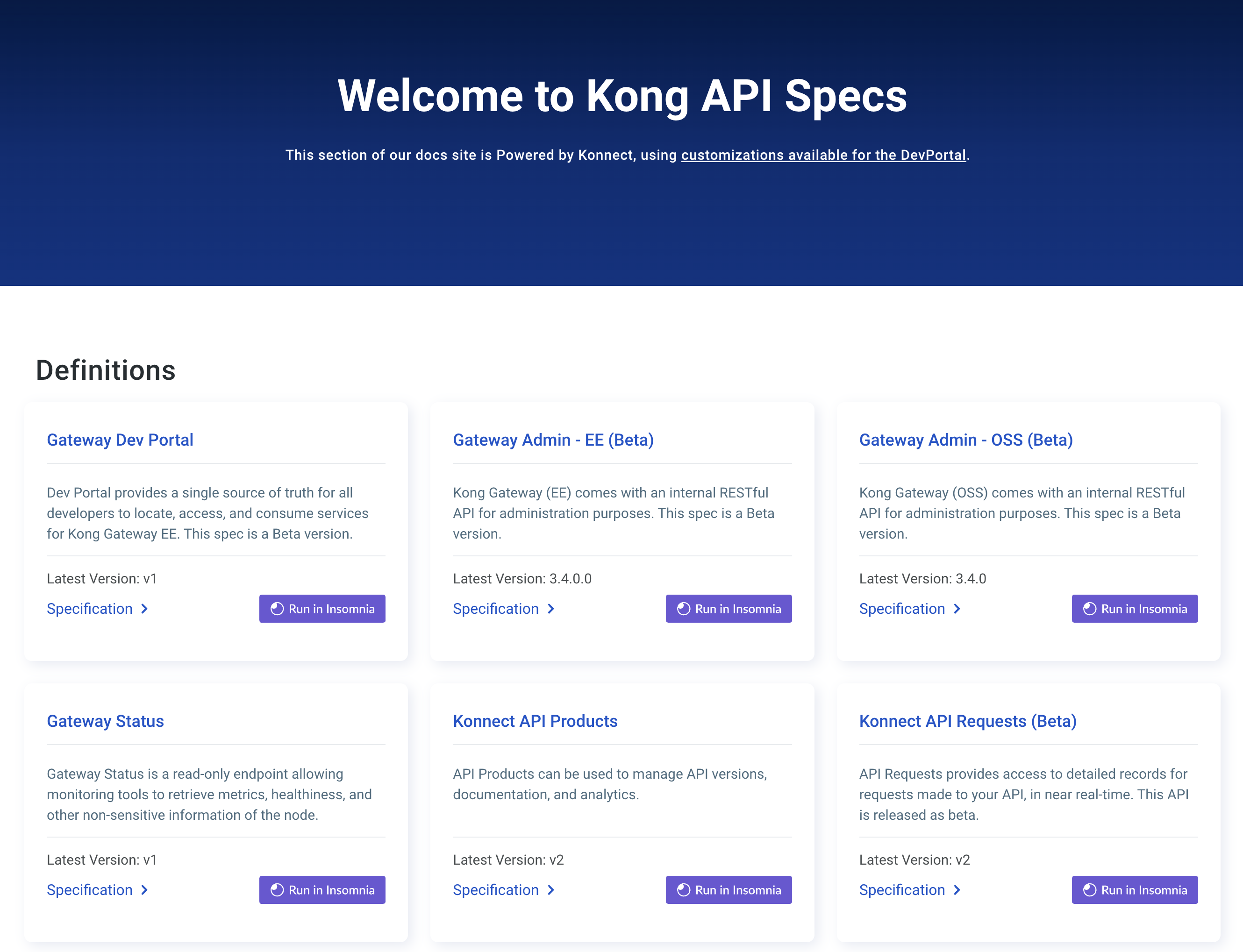このページは、まだ日本語ではご利用いただけません。翻訳中です。
旧バージョンのドキュメントを参照しています。 最新のドキュメントはこちらをご参照ください。
Using Custom Entities
この機能はtech preview(アルファ品質)としてリリースされており、本番環境では依存すべきではありません。
Kong Ingress Controller provides an interface to configure Kong Gateway entities using CRDs.
Some Kong Gateway plugins define custom entities that require configuration. These entities can be configured using the KongCustomEntity resource.
Note: The KongCustomEntity controller is an opt-in feature. You must enable it by setting feature gate
KongCustomEntitytotrueto enable the controller.
The KongCustomEntity resource contains a type field which indicates the type of Kong entity to create, and a fields property which can contain any values that need to be set on an entity.
In the following example, a degraphql_routes entity is created with two properties, uri and query.
spec:
type: degraphql_routes
fields:
uri: "/contacts"
query: "query{ contacts { name } }"
This corresponds to the uri and query parameters documented in the plugin documentation
Tutorial: DeGraphQL custom entities
Prerequisites: Install Kong Ingress Controller with Gateway API support in your Kubernetes cluster and connect to Kong. This guide requires Kong Gateway Enterprise.
Prerequisites
Install the Gateway APIs
-
Install the Gateway API CRDs before installing Kong Ingress Controller.
kubectl apply -f https://github.com/kubernetes-sigs/gateway-api/releases/download/v1.1.0/standard-install.yaml -
Create a
GatewayandGatewayClassinstance to use.echo " --- apiVersion: gateway.networking.k8s.io/v1 kind: GatewayClass metadata: name: kong annotations: konghq.com/gatewayclass-unmanaged: 'true' spec: controllerName: konghq.com/kic-gateway-controller --- apiVersion: gateway.networking.k8s.io/v1 kind: Gateway metadata: name: kong spec: gatewayClassName: kong listeners: - name: proxy port: 80 protocol: HTTP allowedRoutes: namespaces: from: All " | kubectl apply -f -The results should look like this:
gatewayclass.gateway.networking.k8s.io/kong created gateway.gateway.networking.k8s.io/kong created
Install Kong
You can install Kong in your Kubernetes cluster using Helm.
-
Add the Kong Helm charts:
helm repo add kong https://charts.konghq.com helm repo update -
Create a file named
license.jsoncontaining your Kong Gateway Enterprise license and store it in a Kubernetes secret:kubectl create namespace kong kubectl create secret generic kong-enterprise-license --from-file=license=./license.json -n kong -
Create a
values.yamlfile:gateway: image: repository: kong/kong-gateway env: LICENSE_DATA: valueFrom: secretKeyRef: name: kong-enterprise-license key: license -
Install Kong Ingress Controller and Kong Gateway with Helm:
helm install kong kong/ingress -n kong --create-namespace --values ./values.yaml
Test connectivity to Kong
Kubernetes exposes the proxy through a Kubernetes service. Run the following commands to store the load balancer IP address in a variable named PROXY_IP:
-
Populate
$PROXY_IPfor future commands:export PROXY_IP=$(kubectl get svc --namespace kong kong-gateway-proxy -o jsonpath='{.status.loadBalancer.ingress[0].ip}') echo $PROXY_IP -
Ensure that you can call the proxy IP:
curl -i $PROXY_IPThe results should look like this:
HTTP/1.1 404 Not Found Content-Type: application/json; charset=utf-8 Connection: keep-alive Content-Length: 48 X-Kong-Response-Latency: 0 Server: kong/3.0.0 {"message":"no Route matched with those values"}
This example configures custom entities for the degraphql plugin, which allows you to access a GraphQL endpoint as a REST API.
Create a GraphQL Service
The degraphql plugin requires an upstream GraphQL API. For this tutorial, we’ll use Hasura to create an example GraphQL service:
echo 'apiVersion: apps/v1
kind: Deployment
metadata:
labels:
app: hasura
hasuraService: custom
name: hasura
namespace: default
spec:
replicas: 1
selector:
matchLabels:
app: hasura
template:
metadata:
labels:
app: hasura
spec:
containers:
- image: hasura/graphql-engine:v2.38.0
imagePullPolicy: IfNotPresent
name: hasura
env:
- name: HASURA_GRAPHQL_DATABASE_URL
value: postgres://user:password@localhost:5432/hasura_data
- name: HASURA_GRAPHQL_ENABLE_CONSOLE
value: "true"
- name: HASURA_GRAPHQL_DEV_MODE
value: "true"
ports:
- name: http
containerPort: 8080
protocol: TCP
resources: {}
- image: postgres:15
name: postgres
env:
- name: POSTGRES_USER
value: "user"
- name: POSTGRES_PASSWORD
value: "password"
- name: POSTGRES_DB
value: "hasura_data"
---
apiVersion: v1
kind: Service
metadata:
labels:
app: hasura
name: hasura
namespace: default
spec:
ports:
- protocol: TCP
port: 80
targetPort: 8080
selector:
app: hasura
---
apiVersion: networking.k8s.io/v1
kind: Ingress
metadata:
name: hasura-ingress-console
annotations:
konghq.com/strip-path: "true"
spec:
ingressClassName: kong
rules:
- http:
paths:
- path: /hasura
pathType: Prefix
backend:
service:
name: hasura
port:
number: 80' | kubectl apply -f -
Once the Hasura Pod is running, create an API to return contact details using the Hasura API:
curl -X POST -H "Content-Type:application/json" -H "X-Hasura-Role:admin" http://${PROXY_IP}/hasura/v2/query -d '{"type": "run_sql","args": {"sql": "CREATE TABLE contacts(id serial NOT NULL, name text NOT NULL, phone text NOT NULL, PRIMARY KEY(id));"}}'
curl -X POST -H "Content-Type:application/json" -H "X-Hasura-Role:admin" http://${PROXY_IP}/hasura/v2/query -d $'{"type": "run_sql","args": {"sql": "INSERT INTO contacts (name, phone) VALUES (\'Alice\',\'0123456789\');"}}'
curl -X POST -H "Content-Type:application/json" -H "X-Hasura-Role:admin" http://${PROXY_IP}/hasura/v1/metadata -d '{"type": "pg_track_table","args": {"schema": "public","name": "contacts"}}'
Configure the degraphql plugin
The degraphql entity requires you to configure a mapping between paths and GraphQL queries. In this example, we’ll map the /contact path to query{ contacts { name } }.
The KongPlugin CRD creates a new degraphql plugin, and the KongCustomEntity CRD attaches the fields to the KongPlugin in parentRef.
echo '---
apiVersion: configuration.konghq.com/v1
kind: KongPlugin
metadata:
namespace: default
name: degraphql-example
plugin: degraphql
config:
graphql_server_path: /v1/graphql
---
apiVersion: configuration.konghq.com/v1alpha1
kind: KongCustomEntity
metadata:
namespace: default
name: degraphql-route-example
spec:
type: degraphql_routes
fields:
uri: "/contacts"
query: "query{ contacts { name } }"
controllerName: kong
parentRef:
group: "configuration.konghq.com"
kind: "KongPlugin"
name: "degraphql-example"
' | kubectl apply -f -
Once the KongPlugin is configured, you can attach it to an Ingress:
echo '
apiVersion: networking.k8s.io/v1
kind: Ingress
metadata:
name: demo-graphql
annotations:
konghq.com/plugins: "degraphql-example"
spec:
ingressClassName: kong
rules:
- http:
paths:
- path: /contacts
pathType: Prefix
backend:
service:
name: hasura
port:
number: 80' | kubectl apply -f -
Test the Service with the degraphql Plugin
You can access the demo-graphql ingress with the degraphql
plugin attached to verify the degraphql plugin and degraphql_routes entity works:
curl http://${PROXY_IP}/contacts
The curl command should return
{"data":{"contacts":[{"name":"Alice"}]}}
which matches the data inserted in the previous steps.












